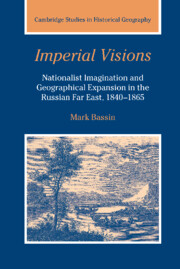 Imperial Visions
Imperial Visions Published online by Cambridge University Press: 06 July 2009
“A useless river”
In the late summer of 1842, a treaty was concluded by the British and the Chinese in the city of Nanking. This agreement brought to an end the hostilities of the so-called Opium Wars, and at the same time initiated a new era in East Asia's relations with the Western world. In their negotiations at Nanking the British had demanded, and were granted, the full cession of the port of Hong Kong and the opening of a further four ports for their commercial activities, to be supported by consular representation. The Russians followed these events carefully, for they understood that the consequences of the British victory would ultimately affect their own position and interests in China. Exactly how these interests would be affected, however, was far from clear. Seen from one standpoint, the course of developments in the Far East offered definite cause for encouragement. In striking contrast to the image of confident power with which the Chinese armed forces had impressed and overwhelmed the Russians in the seventeenth century and kept them at bay ever since, the relatively easy British victory now exposed the Middle Kingdom for the “paper dragon” or helpless giant it had become, and observers in Moscow and St. Petersburg began to appreciate that the strategic balance of forces on the Russia's southeastern frontier had shifted decisively.
To save this book to your Kindle, first ensure [email protected] is added to your Approved Personal Document E-mail List under your Personal Document Settings on the Manage Your Content and Devices page of your Amazon account. Then enter the ‘name’ part of your Kindle email address below. Find out more about saving to your Kindle.
Note you can select to save to either the @free.kindle.com or @kindle.com variations. ‘@free.kindle.com’ emails are free but can only be saved to your device when it is connected to wi-fi. ‘@kindle.com’ emails can be delivered even when you are not connected to wi-fi, but note that service fees apply.
Find out more about the Kindle Personal Document Service.
To save content items to your account, please confirm that you agree to abide by our usage policies. If this is the first time you use this feature, you will be asked to authorise Cambridge Core to connect with your account. Find out more about saving content to Dropbox.
To save content items to your account, please confirm that you agree to abide by our usage policies. If this is the first time you use this feature, you will be asked to authorise Cambridge Core to connect with your account. Find out more about saving content to Google Drive.